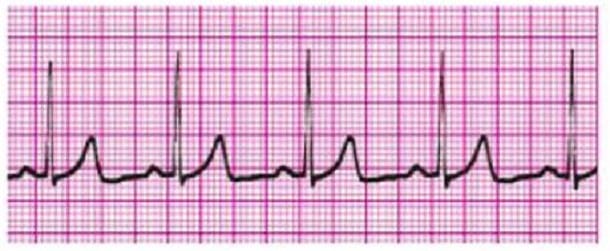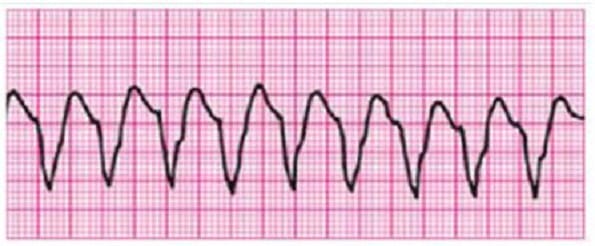Exam Details
Exam Code
:ACLSExam Name
:Advanced Cardiac Life SupportCertification
:Test Prep CertificationsVendor
:Test PrepTotal Questions
:301 Q&AsLast Updated
:Apr 11, 2025
Test Prep Test Prep Certifications ACLS Questions & Answers
-
Question 221:
T/F: Defibrillation "jump starts" the heart?
A. False
B. True
-
Question 222:
A patient has a rapid irregular wide-complex tachycardia. The ventricular rate is 138. He is asymptomatic with a blood pressure of 110/70 mmHg. He has a history of angina. Which of the following actions is pF recommended?
A. Give adenosine 6 mg IV bolus
B. Immediate synchronized cardioversion
C. Give lidocaine 1 to 1.5 mg IV bolus
D. Seek expert consultation
-
Question 223:

A patient becomes unresponsive and you are uncertain if a faint pulse is present with the above rhythm. You next action is
A. Start an IV and give epinephrine 1 mg IV
B. Consider causes for pulseless electrical activity
C. Start an IV and give atropine 1 mg
D. Order transcutaneous pacing
E. Begin CPR with high-quality chest compressions
-
Question 224:
T/F: A poor result after resuscitation is evidence of negligence.
A. False
B. True
-
Question 225:

This patient has been resuscitated from cardiac arrest. During the resuscitation amiodarone 300 mg was administered. The patient developed severe chest discomfort with diaphoresis. He is now unresponsive. What is the next indicated action?
A. Repeat amiodarone 150 mg IV
B. Give tidocaine 1 to 1.5 mg/kg IV
C. Give immediate unsynchronized high-energy shock {defibrillation dosis)
D. Perform immediate synchronized cardioversion
E. Repeat amiodarone 300 mg IV
-
Question 226:

You are the code team leader and arrive finding the above rhythm with CPR in progress. Team members
report that the patient was well but complained of chest pain and collapsed. She has no pulse or respirations. Bag-mask ventilations are producing visible chest rise, high-quality CPR is in progress, and an IV has been established. Your next order would be
A. Start dopamine at 10 to 20 ug/kg per minute
B. Administer atropine 1 mg
C. Administer epinephrine 1 mg
D. Administer amiodarone 300 mg
E. Perform endotracheal intubation
-
Question 227:

You are monitoring a patient. Chest discomfort has been relieved with sublingual nitrates and morphine sulfate 4 mg IV. He suddenly has the above persistent rhythm. You ask about symptoms and he reports mild palpitations, but otherwise he is clinically stable with unchanged vital signs. Your next action is:
A. Give sedation and perform synchronized cardioversion
B. Administer amiodarone 150 mg over 10 minutes; seek expert consultation
C. Give immediate synchronized shock
D. Give immediate unsynchronized shock
E. Administer magnesium sulfate 1 to 2 g IV diluted in 10 mL D5W given over 5 to 20 minutes
-
Question 228:

You are monitoring this patient after successful resuscitation. You note the above rhythm on the cardiac monitor and document a rhythm strip for the patient's chart. She has no complaints and blood pressure if 110/70 mmHg.
Now you would:
A. Give Atropine 1 mg IV
B. Give Atropine 0.5 mg IV
C. Administer sedation and begin immediate transcutaneous pacing at 80 per minute
D. Start dopamine 2 to 10 ug/kg per minute and titrate heart rate
E. Prepare for transcutaneous pacing (place pacing pads, do not pace)
-
Question 229:

You are monitoring a patient with chest discomfort who becomes suddenly unresponsive. You observe the following rhythm on the cardiac monitor. A monophasic defibrillator is present. What is your first action?
A. Give a single shock with 360 J
B. Incubate the patient and give epinephrine 2 to 4 mg via ET tube
C. Begin CPR with chest compressions for 2 minutes or about 5 cycles of compressions and ventilations
D. Establish an IV and give epinephrine 1 mg IV
E. Give a single shock with 200 J
-
Question 230:
T/F: Atropine is used to treat ventricular tachycardia.
A. False
B. True
Related Exams:
AACD
American Academy of Cosmetic DentistryACLS
Advanced Cardiac Life SupportASSET
ASSET Short Placement Tests Developed by ACTASSET-TEST
ASSET Short Placement Tests Developed by ACTBUSINESS-ENVIRONMENT-AND-CONCEPTS
Certified Public Accountant (Business Environment amd Concepts)CBEST-SECTION-1
California Basic Educational Skills Test - MathCBEST-SECTION-2
California Basic Educational Skills Test - ReadingCCE-CCC
Certified Cost Consultant / Cost Engineer (AACE International)CGFM
Certified Government Financial ManagerCGFNS
Commission on Graduates of Foreign Nursing Schools
Tips on How to Prepare for the Exams
Nowadays, the certification exams become more and more important and required by more and more enterprises when applying for a job. But how to prepare for the exam effectively? How to prepare for the exam in a short time with less efforts? How to get a ideal result and how to find the most reliable resources? Here on Vcedump.com, you will find all the answers. Vcedump.com provide not only Test Prep exam questions, answers and explanations but also complete assistance on your exam preparation and certification application. If you are confused on your ACLS exam preparations and Test Prep certification application, do not hesitate to visit our Vcedump.com to find your solutions here.